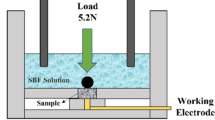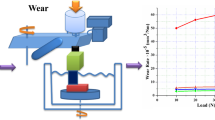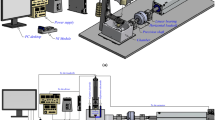The abrasive wear behaviour of several orthopaedic bearing materials was characterized for fully conformal, reciprocating sliding contact against ultra-high molecular weight polyethylene (UHMWPE). The bearing surfaces investigated were nitrogen ion implanted Ti−6Al−4V, TiN coated Ti−6Al−4V, Ti−6Al−4V, F-799 Co−Cr−Mo, yttria-stabilized zirconia and a Zr−2.5Nb alloy with a zirconia ceramic surface. The third-body debris was introduced as either Ti−6Al−4V particles or oxidized titanium powder (black debris). The wear tests were performed in deionized water with the third-body debris entrapped between the UHMWPE and the hard bearing surface. Surface profilometry measurements, scanning electron microscopy (SEM) and optical microscopy showed the severity of damage to the hard bearing surfaces to increase with decreasing hardness. The abrasion damage to the UHMWPE increased as the roughness of the opposing, hard bearing surface increased. Surface profilometry and energy dispersive spectroscopy (EDS) also showed oxidized titanium (black debris) to form an adherent transfer layer on all of the hard bearing surfaces. Nitrogen ion implantation of Ti−6Al−4V was ineffective in reducing wear of both the Ti−6Al−4V substrate and the UHMWPE. Solid yttria-stabilized zirconia and zirconia-coated Zr−2.5Nb showed no evidence of abrasion damage and produced the least amount of UHMWPE wear. These results are attributed to the high hardness and excellent wear resistance of zirconia and the excellent wettability of ZrO2 due to its relatively high ionic character in comparison to metals and covalently bonded compounds.
Similar content being viewed by others
References
P. Bullough “The hip” The Hip Society, Program Chair, Augusto Sarmiento (C. V. Mosby, St Louis, USA, 1973) p. 80.
I. CLARKE, P. CAMPBELL and N. KOSSOVSKY, ASTM Symposium on Biocompatibility of Particulate Implant Materials, October 1990, San Antonio, TX.
P. CAMPBELL, S. NASSER, N. KOSSOVSKY and H. AMSTUTZ, ASTM Symposium on Biocompatibility of Particulate Implant Materials, October 1990, San Antonio, TX.
W. LANZER, G. CRANE, G. HOWARD and J. DAVIDSON, Proceedings of Sixteenth Meeting, Society of Biomaterials, Charleston, SC, 1990.
A. Lombardi, T. Mallory, B. Vaughn and P. Drouiliard, J. Bone Joint Surgery 71-A (1989) 1337.
G. Gualtiero, I. Gualtieri, M. Hendriks and S. Gagliardi, Clin. Orthop. Related Res. 282 (1992) 81.
H. Oonishi, Y. Takayaka and I. Clarke, J. Long-Term Effects of Medical Implants 2 (1992) 37.
P. Zinchner and H.-G. Willert, Clin. Orthop. Related Res. 282 (1992) 86.
E. Rabinowicz, “Friction and wear of materials” (John Wiley, New York, Chichester, Brisbane, Toronto, 1965).
J. ARCHARD, in “The wear control handbook” edited by M. B. Peterson and W. O. Winer (American Society of Mechanical Engineers, 1980).
F. Bowden and D. Tabor, “The friction and lubrication of solids-Part II (Oxford University Press, London, 1964).
D. DOWSON, M. DIAB, B. GILLIS and J. ATKINSON, in “Polymer wear and its control” (American Chemical Society, 1985).
R. Richardson, Wear 11 (1968) 245.
A. Mishra and I. Finnie, Wear 85 (1983) 57.
T. Tateishi, K. Kondo and K. Miura, Proceedings of 33rd Japanese Congress of Materials Research (Society of Materials Science, Kyoto, Japan, 1990) p. 141.
H. Oonishi, H. Igaki and Y. Takayama, Bioceramics 1 (1989) 272.
R. POGGIE, J. WERT, A. MISHRA and J. DAVIDSON in “Wear and friction of elastomers” (American Society for Testing and Materials, STP 1145, 1992).
A. Gustafson, I. Clark, P. Campbell, J. Long Term Effects of Medical Implants, 3 (1993) 91.
S. Mori, Jpn. J. Tribol. 36 (1991) 161.
L. Pauling, “The nature of the chemical bond” (Cornell University Press, Ithaca, NY, 1940).
L. Darkin and R. Gurry, “Physical chemistry of metals”, Ch. 4 (McGraw-Hill, NY, 1953) p. 79.
R. Gates, S. Hsu and E. Klaus, STLE Trib. Trans. 32 (1989) 357.
M. Semlitsch, M. Tehmann, H. Weber, E. Dorre and H. Willert, J. Biomed. Mater. Res. 11 (1977) 537.
R. BUCHANAN, E. RIGNEY and J. WILLIAMS, 21 (1987) 367.
Author information
Authors and Affiliations
Rights and permissions
About this article
Cite this article
Poggie, R.A., Mishra, A.K. & Davidson, J.A. Three-body abrasive wear behaviour of orthopaedic implant bearing surfaces from titanium debris. J Mater Sci: Mater Med 5, 387–392 (1994). https://doi.org/10.1007/BF00058970
Received:
Accepted:
Issue Date:
DOI: https://doi.org/10.1007/BF00058970




